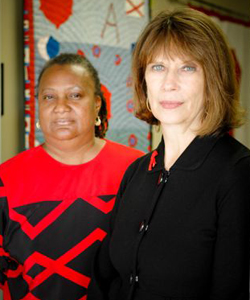Better Understanding of AIDS Stigma Could Lead to Improved Prevention Efforts
By Chris Bryant

To Dr. Pamela Payne Foster, a former New Yorker, the most striking thing about the red brick building on the street corner of the Alabama town was the complete absence of signage indicating its purpose. It was home to an AIDS Service Organization.
Although the non-profit organization’s primary purpose was AIDS advocacy and education, the stigma of HIV/AIDS was so great, its leadership opted not to give any hint to passersby as to the possible reason why a person might be entering its doors. Another Alabama agency had signage, but removed it at the request of its clients.
“That’s so striking to me,” Foster says. “They don’t want to be identified.”
Foster, a preventative medicine physician, now serving as deputy director of UA’s Rural Health Institute for Clinical and Translational Science, trained in Long Island, New York in the early 1990s. “That was earlier when AIDS was associated with a death sentence,” Foster says. “We saw a lot of AIDS cases in Long Island because a lot of the infected persons in New York City were coming home to die.”
During her residency, Foster worked closely with health departments, seeing first-hand, for example, how Nassau County, N.Y. set up its HIV/AIDS bureau and launched its education and prevention groups, one of the country’s first. “There was a lot of fear and controversy,” Foster recalls.
Today, more than 15 years later, some of the fear has abated. The medical establishment better understands the disease, and simple precautions, such as using a condom correctly during sex, have proven effective in preventing the spread of the disease. More is known about how the disease is transmitted and … how it’s not, accurate testing for the virus has been developed, and treatments, while not curing the disease, are enabling those with the disease to live longer, more productive, lives.
Globally, the number of newly reported HIV infections slightly declined between 2001 and 2007 (from 3 million to 2.7 million), as did the number of HIV-related deaths. The number of people living with HIV infection remains stable globally and has actually increased in the U.S. because of treatments, primarily antiretroviral therapy. And, as for the stigma level – it seems ever present.
Foster says she’s been surprised since moving to the South about five years ago at the differences she’s witnessed in disclosure rates between the two regions.
“There are not as many openly HIV positive persons, so the community doesn’t have as much of a concept that it’s an issue,” says Foster, a researcher in UA’s College of Community Health Sciences. “They think they don’t know anybody who has HIV/AIDS.”
A July 2008 report from the Southern AIDS Coalition indicated more than 39,000 Southerners died from AIDS-related illnesses between 2001-2005. During the same period, AIDS-related deaths decreased in all regions of the U.S. except the South.
Better understanding of the stigma associated with the disease has implications for designing new prevention programs, encouraging earlier HIV testing, and improving social support for older people with the disease, according to Foster and her fellow UA researcher, Dr. Susan Gaskins.
The pair, with funding from UA’s Center for Mental Health and Aging, recently conducted a study on the stigma of AIDS in older African-Americans. It is one of the first to look at the stigma of AIDS in older, rural African-Americans in the South.
Initially, the researchers were most interested in learning how older African-Americans coped with the stigma associated with HIV/AIDS, but were struck by how rarely those participating in their focus groups said they disclosed their disease.
Seventy-five percent of those in The University of Alabama study indicated they didn’t feel they could be open with others about their illness.
“Non-disclosure is a way that people manage the stigma they experience,” says Gaskins, a professor of nursing in UA’s Capstone College of Nursing. “It’s how they protect themselves.”
Study participants who did disclose their disease most often told their moms and/or their sisters, the researchers found.
“They felt like they had a closer relationship with their mothers and also they felt like they could trust them not to tell other people and to be supportive,” said Gaskins, who presented the research at the International AIDS Conference in Mexico City in August.
Since disclosure was so limited, participants reported experiencing little to no direct stigma from others, but experienced the most stigma related to their internalized shame, the researchers said.
And while many reported their spirituality, including prayer, helped them cope with the disease, they rarely disclosed it to friends inside or outside the church, according to the University of Alabama researchers.
“When they went to church, they didn’t tell anybody because they weren’t hopeful of getting support,” Gaskins said.

The degree of stigma surrounding the disease is, unfortunately, likely only rivaled by leprosy in Biblical times, Foster says. This stigma stems, of course, from the means whereby HIV infections are spread. Sex with an infected partner and the sharing of contaminated needles are, by far, the two most common means of transmission.
Infected women, according to UA researchers, seem most stigmatized by the fear that people will think they are promiscuous, a drug-user or both. While men are concerned about the links to drug use, it’s the incorrect stereotypical belief that HIV only affects homosexual men that’s most stigmatizing to them, the research indicates.
Thirty-one percent of all new HIV infections in the U.S. in 2006 occurred via heterosexual contact, according to the Centers for Disease Control and Prevention. Fifty-three percent of new infections were related to male to male sexual contact and 12 percent to drug injections. The remaining 4 percent was a combination of male to male sexual contact and drug injections.
“It’s not who you are,” Gaskins says, “it’s what you do.”
Sadly, most of the older African-Americans studied by the UA researchers were not tested for HIV until the virus had significantly advanced. Most of them never considered themselves at risk for the disease, Foster says.
“They saw it as a young person’s disease. They think they are immune … being over 50.” As pregnancy is less of a concern among older adults, they are often less likely to practice safe sex, putting themselves at greater risk, the researchers said.
In 2005, older adults represented 24 percent of people living with HIV/AIDS, and rates of the disease in older adults are 12 times higher for African-Americans than whites, according to the CDC.
“This is a preventable disease,” Gaskins says. “People must take responsibility for their behavior and their health. And, related to that is the education. They have to know.”
Further Reading
Contact
Drew Wood or Linda Hill, UA Media Relations, 205/348-8325, lhill@ur.ua.edu
Source
Dr. Sangita Rayamajhi, srayamajhi@bama.ua.edu Dr. Fran Oneal, director, UA International Honors Program, 205/348-5554, foneal@ua.edu